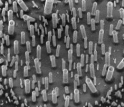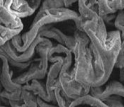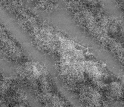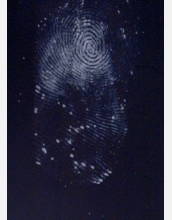|

Discovery
From Fingerprints to Fiberprints

Forensic technique leads to new method for creating nanofibers
February 15, 2006
A keen observation of a fingerprint left on laboratory equipment has now led to a new method for manufacturing nanofibers, nanospheres and other miniscule materials.
In a eureka moment, Pratik Mankidy of Pennsylvania State University noticed that fingerprints he left on a piece of research equipment sprouted nanofibers when they interacted with cyanoacrylate glue (the same substance sold under such brand names as a "super glue").
Forensic scientists have sprayed cyanoacrylates for years knowing that the substance will cause fingerprints to come to light, but the nanofiber potential had never been realized.
Mankidy and fellow Penn State colleague, Ramakrishnan Rajagopalan, and their research advisor Henry Foley--a National Science Foundation awardee and Engineering Advisory Committee member--discovered that the various acids and salts in fingerprints act as initiators to spur cyanoacrylate to grow.
The researchers tweaked various conditions to ultimately arrive at controlled techniques for creating cyanoacrylate nanofibers, nanospheres, nanoscale sheets and even a wrinkle-textured material that the authors have likened to tortellini.
The researchers believe that such controlled manufacture could eventually lead to new clothing materials, drug delivery systems and even wound dressings, as cyanoacrylates are already a well-known medical adhesive.
The researchers announced their findings in the Jan. 26, 2005, issue of the Royal Society of Chemistry journal Chemical Communications.
--Josh Chamot
Investigators
Pratik Mankidy
Ramakrishnan Rajagopalan
Henry Foley
Seong Kim
Paul Weiss
Ayusman Sen
Stephen Fonash
Related Institutions/Organizations
Pennsylvania State University-University Park
Related Programs
Nanoscale Interdisciplinary Research Teams (NIRT)
Related Awards
#0210229 NIRT: Nanoreactor Processes for Manufacturing Oriented Materials
Total Grants
$1,130,957
|

Polymer fibers grow on a fingerprint.
Credit and Larger Version

Pennsylvania State University team studies the fingerprint-cyanoacrylate relationship.
Credit and Larger Version

Henry C. Foley, professor of chemical engineering at Pennsylvania State University.
Credit and Larger Version

Researchers used the chemical reaction to create "tortellini-like" polymer films.
Credit and Larger Version

The researchers grew these polymer nanofibers using a synthetic starting mixture.
Credit and Larger Version

Scanning electron microscope images of nanofibers of poly (ethyl 2-cyanoacrylate)
Credit and Larger Version
|








